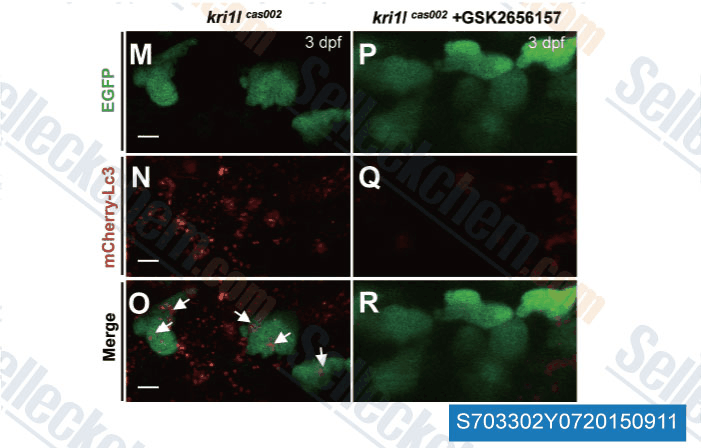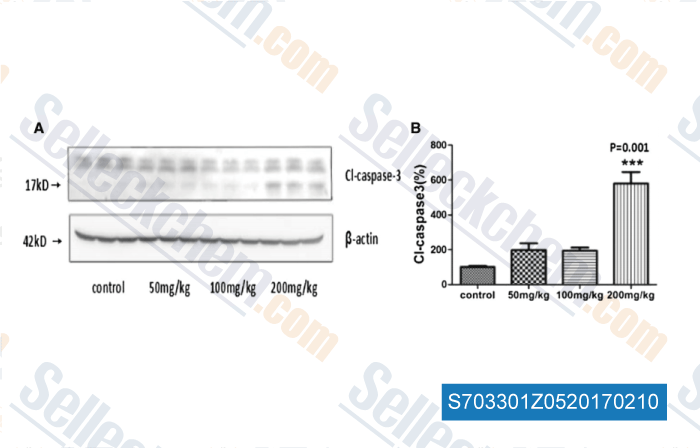|
Toll Free: (877) 796-6397 -- USA and Canada only -- |
Fax: +1-832-582-8590 Orders: +1-832-582-8158 |
Tech Support: +1-832-582-8158 Ext:3 Please provide your Order Number in the email. |
Technical Data
| Formula | C23H21FN6O |
|||
| Molecular Weight | 416.45 | CAS No. | 1337532-29-2 | |
| Solubility (25°C)* | In vitro | DMSO | 20 mg/mL (48.02 mM) | |
| Ethanol | 10 mg/mL (24.01 mM) | |||
| Water | Insoluble | |||
|
* <1 mg/ml means slightly soluble or insoluble. * Please note that Selleck tests the solubility of all compounds in-house, and the actual solubility may differ slightly from published values. This is normal and is due to slight batch-to-batch variations. * Room temperature shipping (Stability testing shows this product can be shipped without any cooling measures.) |
||||
Preparing Stock Solutions
Biological Activity
| Description | GSK2656157 is an ATP-competitive and highly selective inhibitor of PERK with IC50 of 0.9 nM in a cell-free assay, 500-fold greater against a panel of 300 kinases. GSK2656157 decreases apoptosis and inhibits excessive autophagy. | ||
|---|---|---|---|
| Targets |
|
||
| In vitro | Pretreatment of cells with GSK2656157 results in inhibition of PERK activation as well as decreases in the downstream substrates, phospho-eIF2a, ATF4, and CHOP with an IC50 in the range of 10-30 nM. Cells that are exposed to 1 mM GSK2656157 before UPR induction are able to block this effect on de novo protein synthesis. Five of 84 UPR-related genes (DDIT3, HERPUD1, PPP1R15A, C/EBP-beta, and ERN1) are down regulated more than 4-fold by GSK2656157. In the absence of exogeneous UPR inducers, GSK2656157 has no significant effect on the growth of any of these cells with IC50 range of 6–25 mM. Thus, GSK2656157 can be used to evaluate the biologic function of PERK in various biologic contexts. [1] | ||
| In vivo | Complete inhibition of phospho-PERK Thr980 is observed through 8 hours after a single 50 mg/kg oral dose of GSK2656157. Treatment of mice with 50 or 150 mg/kg twice daily dosing of GSK2656157 results in dose-dependent inhibition of tumor growth in four models; reaching 54–114% tumor growth inhibition at the 150 mg/kg, twice daily dose. Altered amino acid metabolism, decreased blood vessel density, and vascular perfusion are potential mechanisms for the observed antitumor effect. Treatment of mice with GSK2656157 results in inhibition of tumor growth in multiple human tumor xenografts. [1] | ||
| Features | Orally bioavailable PERK-selective inhibitor that functions independent of eIF2α phosphorylation. |
Protocol (from reference)
| Kinase Assay: |
|
|---|---|
| Cell Assay: |
|
| Animal Study: |
|
Customer Product Validation

-
Data from [Data independently produced by , , Cell Res, 2015, 25: 946-962]

-
Data from [Data independently produced by , , Neurotox Res, 2017, 31(2):218-229.]
Selleck's GSK2656157 has been cited by 44 publications
| Mannose metabolism inhibition sensitizes acute myeloid leukaemia cells to therapy by driving ferroptotic cell death [ Nat Commun, 2023, 14(1):2132] | PubMed: 37059720 |
| Loss of PERK function promotes ferroptosis by downregulating SLC7A11 (System Xc⁻) in colorectal cancer [ Redox Biol, 2023, 65:102833] | PubMed: 37536085 |
| A program of successive gene expression in mouse one-cell embryos [ Cell Rep, 2023, 42(2):112023] | PubMed: 36729835 |
| Young and undamaged recombinant albumin alleviates T2DM by improving hepatic glycolysis through EGFR and protecting islet β cells in mice [ J Transl Med, 2023, 21(1):89] | PubMed: 36747238 |
| Acute Endoplasmic Reticulum Stress Suppresses Hepatic Gluconeogenesis by Stimulating MAPK Phosphatase 3 Degradation [ Int J Mol Sci, 2023, 24(21)15561] | PubMed: 37958545 |
| Rilotumumab Resistance Acquired by Intracrine Hepatocyte Growth Factor Signaling [ Cancers (Basel), 2023, 15(2)460] | PubMed: 36672409 |
| PERK arm of UPR selectively regulates ferroptosis in colon cancer cells by modulating the expression of SLC7A11 (System Xc-) [ bioRxiv, 2023, 10.1101/2023.03.28.534659] | PubMed: none |
| PERK is a critical metabolic hub for immunosuppressive function in macrophages [ Nat Immunol, 2022, 23(3):431-445] | PubMed: 35228694 |
| A non-canonical cGAS-STING-PERK pathway facilitates the translational program critical for senescence and organ fibrosis [ Nat Cell Biol, 2022, 24(5):766-782] | PubMed: 35501370 |
| Scleral PERK and ATF6 as targets of myopic axial elongation of mouse eyes [ Nat Commun, 2022, 13(1):5859] | PubMed: 36216837 |
RETURN POLICY
Selleck Chemical’s Unconditional Return Policy ensures a smooth online shopping experience for our customers. If you are in any way unsatisfied with your purchase, you may return any item(s) within 7 days of receiving it. In the event of product quality issues, either protocol related or product related problems, you may return any item(s) within 365 days from the original purchase date. Please follow the instructions below when returning products.
SHIPPING AND STORAGE
Selleck products are transported at room temperature. If you receive the product at room temperature, please rest assured, the Selleck Quality Inspection Department has conducted experiments to verify that the normal temperature placement of one month will not affect the biological activity of powder products. After collecting, please store the product according to the requirements described in the datasheet. Most Selleck products are stable under the recommended conditions.
NOT FOR HUMAN, VETERINARY DIAGNOSTIC OR THERAPEUTIC USE.
